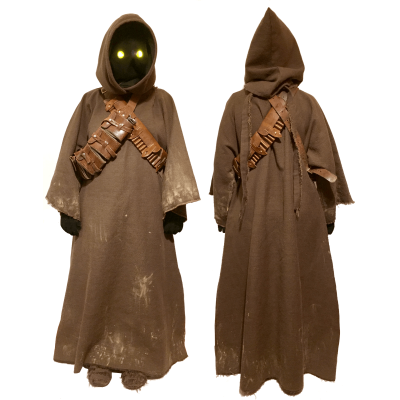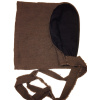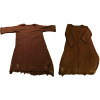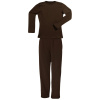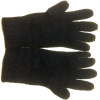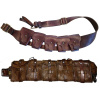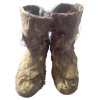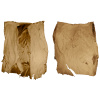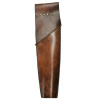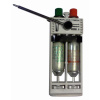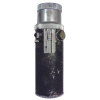Jawa
Model DZ-3016, Photo by Kelly Wicks Preshaw
Description: Jawa
Prefix: DZ
Detachment: Krayt Clan
Context: Star Wars Films and EU
See also: Offworld Jawa
Jawas were passionate scavengers, seeking out technology for sale or trade in the deep deserts in their huge sandcrawler transports. They had a reputation for swindling, as they had a penchant for selling old equipment such as outdated faulty droids to moisture farmers. However, they were extremely passive beings, and hardly put up any resistance to colonists of their planet unlike the other natives the Sand people, instead seeing foreigners as an excellent business opportunity.
This Visual Guide has been reviewed by the detachment staff and the LMO team and is certified for use as a minimum approval guideline for GMLs. GMLs are free to approve this costume type.
This is a visual guide used for 501st costume approval, not a how-to for construction. Construction details are found at the costume's Detachment website. Measurements provided here are generalized, and not criteria for approval. All 501st costumes are proportionate to the wearer in terms of size, fit, and scale. During evaluation, both text and images (CRL and Reference) must be considered. When in doubt about a feature of a submitted costume, GMLs should post questions in the Legion forum's DL/GML peer review section.
Required Costume Components
The following costume components are present and appear as described below. For 501st membership only the requirements in black need to be met.
Mask
- The mask is a base upon which to mount the two glowing eyes.
- The Mask has a shroud, constructed of a black material, that hides the entire head and face of the costumer (No parts of the wearer may be visible).
- A black mesh fabric may be used to cover the front of the mask.
- ”Speaker cloth” is commonly used for the front of the mask.
- Eyes: When the mask is worn with the costume, only the illuminated eyes are visible from inside the hood.
- The eyes illuminate by "glowing", not "projecting".
- The use of mini-flashlights or other reflectors that emit a beam of light is incorrect.
- A simple incandescent lamp or non-directional LED is ideal.
- The eyes are yellow or light orange (amber) in color and sized at 1 to 1.25in (2.5 to 3.2 cm) in diameter.
- Eyes do not bulge out too far from the mask.
- No more than 1” (2.5cms) is ideal.
- Unmodified gumball-machine cups are too deep.
- Eyes are placed below the wearers own eyes, to enhance the “alien look” of the costume.
- Special note: Jawa eyes in ANH are relatively small; Jawa eyes in ROTJ are larger and appear to be amber acrylic cabochons.
Hood
- The hood is made of the same material as the robe, and has a hemmed edge.
- The only seam on the hood is in the back "No top seam"
- A brown, dark brown, rust-brown Blanket weave being a heavy fabric.
- The inside of the hood is lined with solid black fabric.
- Hood does not slouch over the mask.
- To achieve the correct look and maintain proper visibility, a wire or plastic reinforcement is sewn into the edge of the face opening.
- Hood is sufficiently large to lap over (the robe, hiding the neck opening) and onto the shoulders.
- The front edge of the hood opening have two long “tails” / flaps / strips.
- The flaps cross in the front, pulling the hood closed.
- The flaps continue around the neck and tied in the back.
- The rest of the flaps hang down the back or tacked in the hood.
- The hood may show signs of weathering
- The robe is made of the same material as the hood.
- A brown, dark brown, rust-brown Blanket weave being a heavy fabric.
- Robe pattern is such that there are no visible seams.
- Body of robe is an “A” line shape, with a wide, full hem (for a child-like appearance). No Straight line cuts or fitted.
- If fabric cannot be found wide enough, separate sleeves may be attached. Sleeve seam is as inconspicuous as possible. Seams are only to be attached to the main robe, none on the shoulders or arms
- There are no seams down the center back of the robe.
- There are no seams around the arms (at the biceps), or down the outside of the arms.
- Length of sleeves to cover wrist not whole hand, width of sleeve to mirror underarm size.
- The robe may be sewn closed, or has an off center (to the side) opening that runs the length of the garment.
- Ideally the only visible seams that appear are the right and left sides of the body from armpit to hem, and on the underside of the sleeves from armpit to cuff.
- The openings of the sleeves and robe bottom are not roll-hemmed.
- Some fraying at the hem and sleeves, but no long loose threads or unkempt appearance.
- Robe is weathered with dust and dirt where it would happen naturally, but does not resemble grease marks or staining from wetness, or bleaching.
- Special note: Jawa robes in ANH have sandy clay in places and either tiny bit of fray on the sleeves to none at all; Jawa robes in ROTJ have no sandy colored weathering at all, look generally clean and have frayed sleeves.
Undergarments
- Black or brown undergarments are used to cover the arms, legs, and any other areas where skin or clothing might be exposed (such as when moving or kneeling).
Gloves
- The gloves are constructed of black cloth, (non-shiny) leather or leather-like material.
- Gloves are plain with no adornments such as buckles or straps.
- Gloves cover the hands and entire wrist.
- Optional: Black short fur may be attached to the gloves on top of the hands and even up the arms.
Bandoliers
- At least one (1) bandolier is worn across the chest.
- Bandoliers are of British 1903 pattern, Martini Henry, Turkish Ottoman, Swedish, British, NZ, Australian, Canadian, German or similar recreations, and matching the style in the movie.
- Bandoliers are of brown/black leather or similar looking material and visual weight.
- The bandolier(s) are aged and weathered.
- All metal pieces are dull, worn and scuffed with little or shine to them.
- Chest bandoliers are not worn tight up under the armpit area; they reach at least to the waist.
- Extension straps may be needed for the bandoliers in order for them to hang low enough.
- Up to two (2) bandoliers may be worn at the same time.
- One bandolier across the shoulder to the waist.
- Two crossed over the chest in an “X” formation to the waist.
- Jawas do not wear bandoliers around the waist.
Boots
- The boots are wrapped in the same brown textured fabric as used to construct the hood and robe.
- The boots are tall enough to cover the mid-shin or higher.
- The boots are weathered in the same manner as the hood and robe.
Optional Accessories
Items below are optional costume accessories. These items are not required for approval, but if present appear as described below. If adding in an accessory after initial approval, the item still needs to be submitted to local GML for approval before use.
Vest
- The vest is made of a tan textured, heavy-weight fabric.
- The vest is weathered with various brown colored staining and tattered areas.
Ion Blaster, ANH
- This is one acceptable version of ion blaster.
Ion Blaster, RotJ
- This is another acceptable version of ion blaster.
Holster
- The holster in which to carry the Ion Blaster.
Torch welder
- Microflame gas brazing torch or similar.
- Box frame with two (2) control knobs on top, extended torch arm, and cylinders in center.
Droid caller
- Made from a vintage Kobold camera flash, or replica.
- Cylindrical tube with a silver upper section and a black textured lower section, silver rectangle detail piece is attached to center, with several small knobs on side.
